|
MEMORIES
AND INFORMATION - WORCESTERSHIRE
CRABBS
CROSS, HEADLESS CROSS, HEWELL and WEBHEATH
defended
by
"C"
Company, 9th WORCESTERSHIRE (REDDITCH) BATTALION
|
This
is a page within the www.staffshomeguard.co.uk website. To
see full contents, go to SITE
MAP.
Local historian Mike Johnson of Cookhill
is actively researching the history of the 9th (Redditch)
Battalion, Worcestershire Home Guard and its role in the defence
of Worcestershire. The first result of his researches, on
the subject of "D" Company which defended Cookhill
and the surrounding area, already appears elsewhere within this website. He has now completed further work, this
time on "C" Coy. of the same Battalion and we are
greatly indebted to him for allowing us to reproduce it here
in its entirety and to those who contributed the information
and images.
"C" Coy's. territory was the
villages of Crabbs Cross, Headless Cross, Hewell and Webheath.
Individual platoons within the Company had responsibility
for specific villages or areas. The Battalion's Commanding
Officer in early 1941 was Lt. Col. A.E. Scothern, C.M.G.,
D.S.O. Company Commanders were at that time Majors E.A.
Grace, R.C. Morom, W.F.F. Scott, M.C., F. Twist, M.C., M.M.
and H. Wright. A further 48 officers were listed at this time.
From the following article it appears that Major J.F.S. Mellor
was later promoted and assumed command of "C" Company.
If you have any information, however minor,
about any of the units within the 9th Worcestershire (Redditch)
Battalion, the author is anxious to hear from you. You can
contact him by clicking
here.
THE
STORY OF "C" COMPANY, 9th WORCESTERSHIRE (REDDITCH)
BATTALION HOME GUARD
by
Mike Johnson
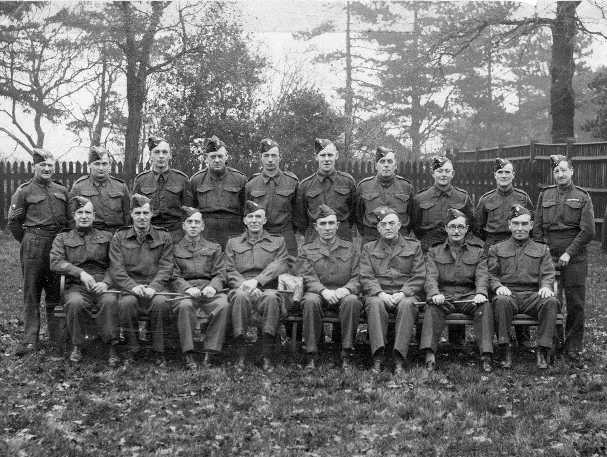
OFFICERS
and N.C.O's of "C" COMPANY
9th WORCS. (REDDITCH) HOME GUARD BATTALION
(Click on the image for a higher definition
version and two others, incl. captions)
Crabbs Cross, Headless
Cross, Webheath, and Hewell, formed
"C" Company of the 9th Worcestershire (Redditch)
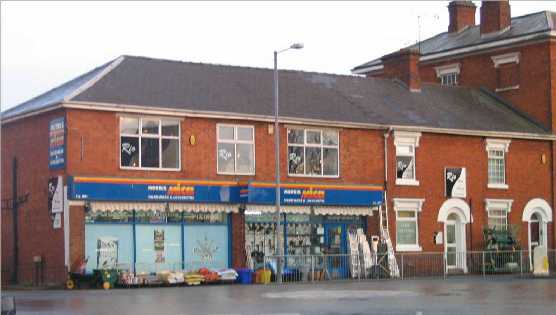 Battalion,
Home Guard. The company consisted of four platoons comprising
20-30 men in each platoon. Company Commander was Major
Mellor from Hewell with
Phillip Terry as second in Command.
Their Company headquarters were located over the former Alcester
Co-op at Headless Cross, a building
now occupied by Morris's shop
(see right). Battalion,
Home Guard. The company consisted of four platoons comprising
20-30 men in each platoon. Company Commander was Major
Mellor from Hewell with
Phillip Terry as second in Command.
Their Company headquarters were located over the former Alcester
Co-op at Headless Cross, a building
now occupied by Morris's shop
(see right).
Albert Wharrard
and Bill Preece are to the best
of my knowledge the only two remaining Home Guardsmen of "C"
Company alive today.
Bill Preece
joined the LDV about a week after it started in 1940. On Churchill's
orders the LDV was quickly renamed the Home Guard. Initially
they had no uniforms and only two rifles. Bill was unsure
whether the rifles even had any ammunition but concluded that
they must have been loaded to be of any use. These were kept
at Crabbs Cross Police Station,
which was located on the corner of Yvonne
Rd and Evesham Rd and
they had to be brought up to HQ each night for use by the
men going on duty. With these two rifles "C" Company
had to guard the Power Station, near The
Folly (OS Grid Reference SP 03686545), against the
possible attack by German parachutists. Each night a section
of 8 men would be marched down to take guard. On site was
a wooden hut which served as a guardroom, the guard being
mounted on the entrance road. The arrangement was that two
HG personnel did a two hour guard duty and when off duty then
tried to get some sleep on one of the wooden bunks inside
the hut. However if there was an air raid in progress the
whole guard was turned out. On occasions patrols were sent
out to look for German airmen who may have bailed out from
their aircraft, the search would go on into the night and
no one would get any sleep. It is worth remembering that all
the HG men had been at work all day, they would then on occasions
possibly be up all night, but despite this fact they were
only allowed to be one hour late for work next day - well,
there was a war on!
Albert Wharrad joined
the Home Guard in March 1941 when he was 16 years and one
month and was issued with a uniform, rifle, boots, and gaiters,
a belt and webbing equipment complete with two ammunition
pouches, a service gas mask, a steel helmet and an army greatcoat.
Albert, being slight of build, found that with the bayonet
fixed, and when the butt of the rifle was on the ground, the
bayonet point towered above his head by at least four or five
inches.
As with other companies in the Battalion,
"C" Company was issued with the American P17 rifle
of Great War vintage complete with the bayonet. The rifles
were in new condition when they arrived, but were covered
in protective grease, which had to be cleaned off. The main
drawback being that they fired a ·300 rimless cartridge;
this was not compatible with the standard British army ammunition,
which were ·303.
As time progressed more weapons became
available to the H.G. One of them, the Browning automatic
rifle, which could fire either single shots or short bursts
of fire, was a cumbersome weapon with only a 20 round magazine.
Officers had revolvers; senior N.C.O's were issued with Sten
Guns.
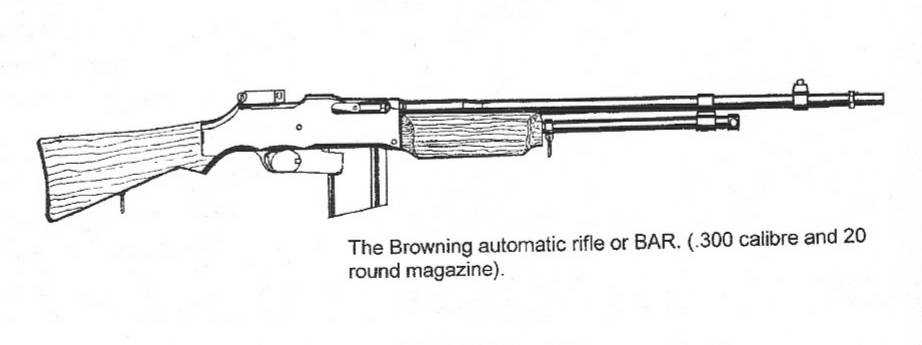 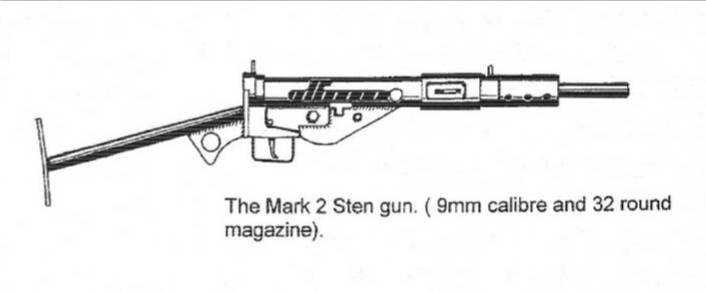
Despite being volunteers (conscription
was not introduced until 1942) it was compulsory to attend
parades, a very good reason was required for failing to turn
up, and both men felt that the discipline was as strict as
in the regular army. Rifle drill was initially held in the
room above the Headless Cross Co-op,
but this annoyed the people downstairs, so, as an alternative,
if it was wet, the long room at the back of the White
Hart pub was used. Alternatively if it was dry and
daylight, use was made of the playground at St
Luke's Infants School, Evesham
Rd, Headless Cross (now demolished).
Rifle shooting was practiced at Hampton
Lovett, Drotwich, where the Worcestershire Regiment
had a rifle range. Battle training with the regular army was
also carried out here. Bill had a close call when he was a
member of the butts party. Behind the targets was a brick
wall to stop the bullets going out over the countryside. On
one occasion a bullet ricocheted back off the wall and hit
him on his steel helmet, leaving a mark, if not a dent. Had
he been wearing his forage cap he would have been a goner!
He has kept the spent bullet to remind him of this close call.
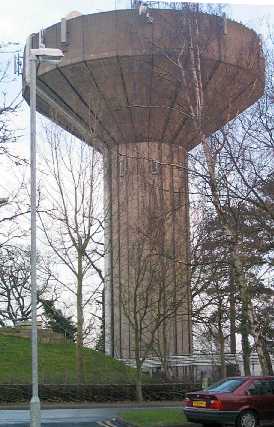
Another duty of the HG was to man the telephone
at HQ. For this two men would be on duty all night but before
dawn one of these men would go to an observation post established
at Highfields, the former home
of Dr Henderson.
This was located about 200yds to the east of the junction
between Birchfield Rd and Evesham
Rd (OS Grid Reference SP 03926601) being the highest
point in the village from where the observer could watch for
parachutists. A water tower (left)
now occupies the site of this former OP. (It was generally
expected that the Germans would make a surprise attack using
parachutists to capture key objectives at or before dawn,
as they had done on the Continent.)
Bill can remember coming off Home Guard
night duty at 6.00 am, going home to change and then being
at work at the Royal Enfield
works by 7.00 am He would then work an eleven hour shift,
very often falling asleep at his machine, and arrive home
again at 7.00 pm, possibly having to be back on Home Guard
duty again by 8.00 pm.
It was the H.G. duty to man roadblocks.
So far only the location of two has been established, one
at the top of Plymouth Rd, consisting
of two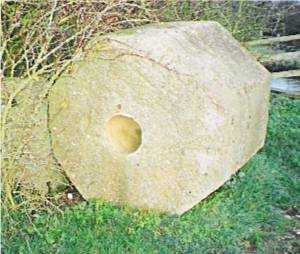 large concrete cylinders, these would have been rolled out
and equally spaced to block the road. The other was situated
at the top of Mount Pleasant
at the entrance to what is now the Comfort
Hotel - in 1940 the home of Alderman
Charles Terry. This roadblock consisted of reinforced
concrete cylinders, about six feet tall, octagonal in shape.
Pieces of wood were fixed to the edges of the octagon so as
to form a round end allowing it to be rolled. With several
men pushing it could be rolled into position. Having got it
into place, one of the wooden pieces was knocked off so that
it settled on one of the flats. Several of these, when in
position, would effectively block the road to any vehicle.
large concrete cylinders, these would have been rolled out
and equally spaced to block the road. The other was situated
at the top of Mount Pleasant
at the entrance to what is now the Comfort
Hotel - in 1940 the home of Alderman
Charles Terry. This roadblock consisted of reinforced
concrete cylinders, about six feet tall, octagonal in shape.
Pieces of wood were fixed to the edges of the octagon so as
to form a round end allowing it to be rolled. With several
men pushing it could be rolled into position. Having got it
into place, one of the wooden pieces was knocked off so that
it settled on one of the flats. Several of these, when in
position, would effectively block the road to any vehicle.
Albert received training on another use
for the hand grenade that was to fire it from a cup discharger.
This was a steel cup about the size of a straight-sided beer
glass, with a hole in the bottom, which then fitted over the
end of the rifle barrel and locked in place. Into the rifle
breech was fed a balastite cartridge ie, a cartridge without
a bullet attached.
You then took a Hand Grenade (better known
as a Mills Bomb) with a round metal plate fixed to its bottom;
this plate was of a size to give it a snug fit inside the
cup. The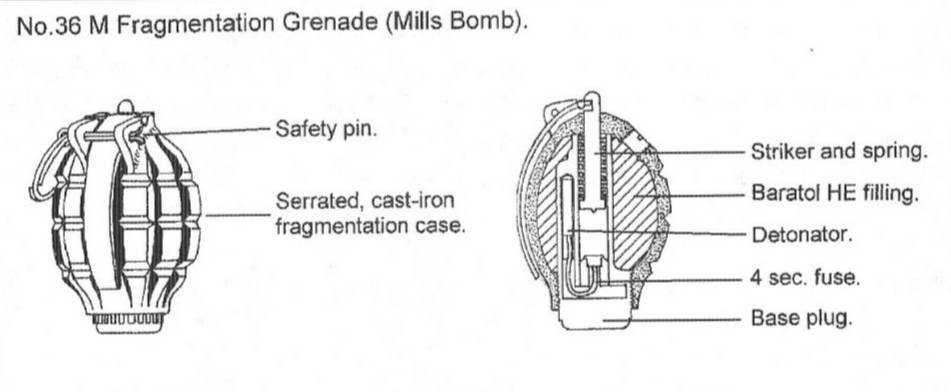 safety pin was pulled out of the grenade and placed base plate
down into the cup of the rifle. Once it was inside the cup
the side of the cup held the safety lever in place and prevented
the grenade from exploding. You then knelt down on one knee
placed the butt of the rifle on the ground. When ready, you
pressed the trigger, held your breath and went temporarily
deaf! The cartridge exploded, the charge of gas went up the
barrel hitting the grenade base plate and throwing it with
force towards the target. The time in flight was about the
same time as the fuse setting in the grenade (approx 4-5secs).
With the rifle angled forward at about 45 degrees and aimed
at the enemy it would throw a grenade about 120yards.
safety pin was pulled out of the grenade and placed base plate
down into the cup of the rifle. Once it was inside the cup
the side of the cup held the safety lever in place and prevented
the grenade from exploding. You then knelt down on one knee
placed the butt of the rifle on the ground. When ready, you
pressed the trigger, held your breath and went temporarily
deaf! The cartridge exploded, the charge of gas went up the
barrel hitting the grenade base plate and throwing it with
force towards the target. The time in flight was about the
same time as the fuse setting in the grenade (approx 4-5secs).
With the rifle angled forward at about 45 degrees and aimed
at the enemy it would throw a grenade about 120yards.
Live grenade throwing was carried out in
Pitcher Oak Wood, Redditch under
the supervision of the Battalion weapons officer Capt.
Seal. Here Bill had another lucky escape from injury.
After the detonator had been put into the grenade as directed
he moved forward into the assembly area, then forward to the
Waiting Bay and finally into the Throwing Bay. Here the procedure
was to remove the safety pin, throw the grenade then duck
below the parapet when ordered. In ducking it was necessary
to go straight down, bending the knees not your neck. On this
occasion the order was slow in being given so that he actually
saw the explosion and to avoid the blast quickly bent his
neck. The result was a blow on the back of his neck with a
piece of soft clay. Had it been shrapnel he might have been
badly injured if not killed.
Bill also recalls the proficiency tests
he had to undergo for his sergeant's stripes, the first being
to dismantle and reassemble a Browning automatic rifle under
the gaze of the Battalion's Weapons Officer. The second test
was grenade throwing at the range in Pitcher
Oak Wood, Redditch; he had to do the grenade throwing
exercise twice because his proficiency papers were lost.
After receiving his sergeant's stripes
his role changed and he was expected to lead his section on
reconnaissance patrols in the area. A typical such patrol
within the Battalion territory is shown below. Should there
have been an invasion, their task was to pin down any Germans
that came into the area, and then send back a runner to Company
Headquarters with the information.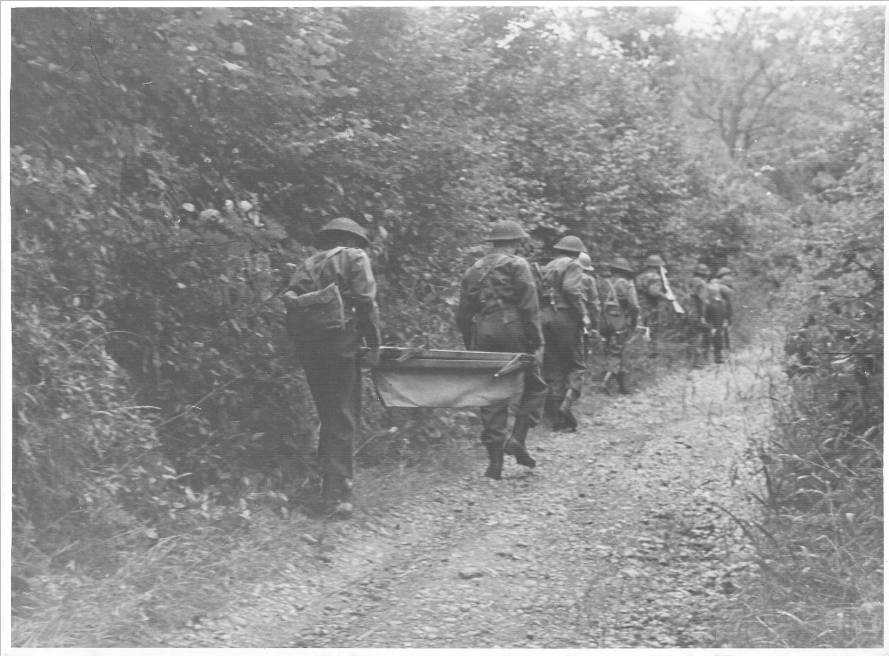
Nearly every weekend was taken up by training
exercises. The Homeguardsmen would report to Company HQ, and
from there they would be marched off to various locations,
sometimes it would be Musketts Wood,
often in the fields where Woodrow, Lodge
Park and Oakenshaw Estates
now stand. Both men have memories of exercises, which took
place at night as well as during the day, in Redditch
and its surrounding area. One particular exercise was an "attack"
by the Worcestershire Regiment,
when the HG waited in an ambush position in the ditches at
the top of Red Lane and the junction
of Birchfield Rd. HG came
out on top, taking the attackers by complete surprise. Another
one when Redditch was "attacked"
by the Warwickshire Home Guard. These attacks would be to
test the efficiency of the Redditch defence, the town having
been designated an Anti-Tank Island in 1940, and so had to
be defended at all costs.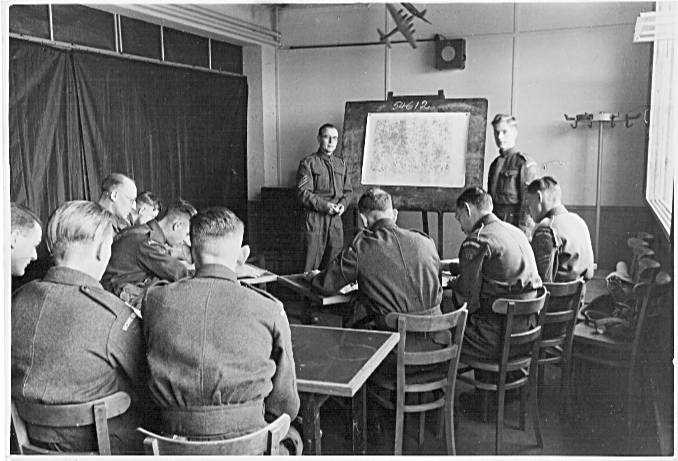 Indoors training like map reading,
how to use a compass and bayonet drill were also carried out
in the long since demolished St Lukes
Memorial Hall, Rectory Rd. A typical
9th Battalion class is shown on the left.
Indoors training like map reading,
how to use a compass and bayonet drill were also carried out
in the long since demolished St Lukes
Memorial Hall, Rectory Rd. A typical
9th Battalion class is shown on the left.
Albert recalls one amusing episode, when
out training. "It was often the practice when marching
along a road for the N.C.O. in charge to shout "enemy
aircraft" at which point you took what cover was available
and pointed your rifle skywards. On this occasion, in Birchfield
Rd, Headless Cross we were given the order and we all
scrambled for cover. One of the H.G took cover by scaling
the low garden wall in front of the house, next to which was
then Bill Brazil's sweet shop,
lost his balance and with a loud crash of broken glass found
that his rifle barrel was sticking through the window of the
house". Embarrassment all round and no doubt a long protracted
argument as to who paid!
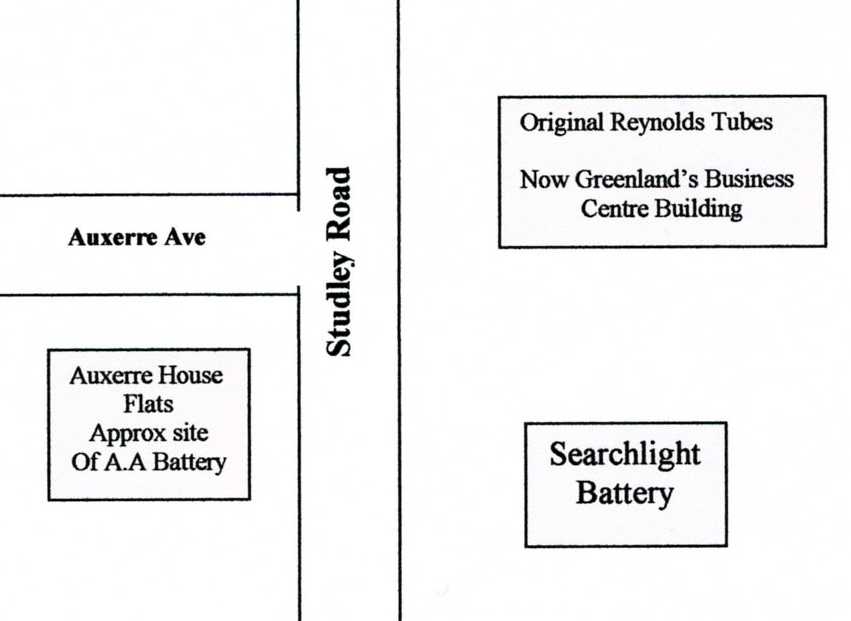
C" Company as with other companies
in the battalion had to provide men for night guard duty at
Reynolds Tubes, Studley Rd, Redditch
(now Alcan). Sometimes there were up to 50 Home Guardsmen
on duty at one time. Guards were posted and those who got
any sleep slept on the floor. One Home Guardsman had to spend
the night at a Royal Artillery anti-aircraft battery on the
other side of Studley Rd approximately where Auxerre
House now stands. That man's duty was to quickly carry
any message to the Home Guard about the approach of German
aircraft or of the warning about enemy parachutists. Albert
was fortunate to get this duty twice, consequently had, and
enjoyed, an Army breakfast before leaving for home, then straight
to work, where one was allowed to be up to one hour late.
(Despite intensive research no reason can be found why so
many HG men were sent to Reynolds Tubes and not to other factories).
In 1942 the Duke of Kent visited Redditch
and Bill was picked to form part of the Guard of Honour. Training
for this occasion was intense and resulted in much practice
at the Drill Hall, Church Rd, Redditch,
as drill had to be perfect. Due to the perfection needed it
resulted in staying one night from 8pm to 1am to perfect the
drill! On the day of the visit they marched from the Drill
Hall, bayonets fixed, to the take up position outside the
old Select Cinema, located
on the junction of Red Lion St and
Alcester St.
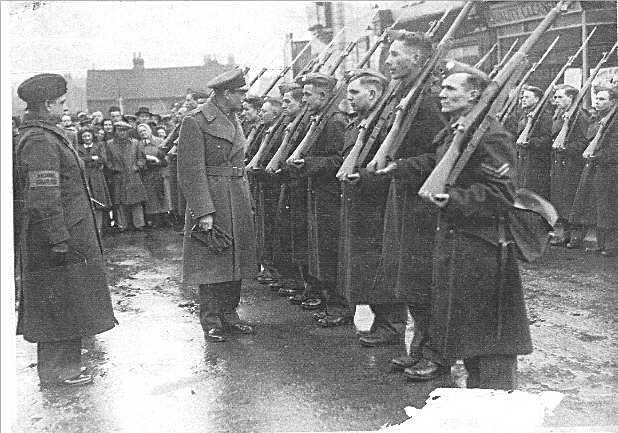
GUARD OF HONOUR
Bill is 6th from the right on the front rank
H.R.H.is talking to Bill's brother
The officer in charge is Major R.C.Morom
Both men agree that in the
early days the Home Guard was poorly armed and trained, but
as more weapons and equipment, including light artillery,
became available, training exercises stepped up and stricter
discipline enforced, that with the support of the regular
army the Redditch Battalion some 2000 strong would have been
a force to be reckoned with.
******************
Much of the information in this article
is based on the reminiscences of Bill Preece and Albert Wharrad,
to whom the author makes due acknowledgement. Several of the
images and pictures reproduced above come by courtesy of Peter
Grace, Bill Preece, Albert Wharrad, and Mick Wilks.
Research is ongoing into the 9th (Worcestershire)
Redditch Home Guard Battalion any information will be greatly
appreciated.
Mike
Johnson
©
M. Johnson 2006
Please click
here for captioned images of members of "C"
Company
Mike Johnson published in February 2009 an excellent book, packed with images and information, entitled "The Redditch Home Guard 1940-1945" - the 9th Worcestershire (Redditch) Battalion. It is priced at £5.85 (+£2.50 p&p.)
and is still available.
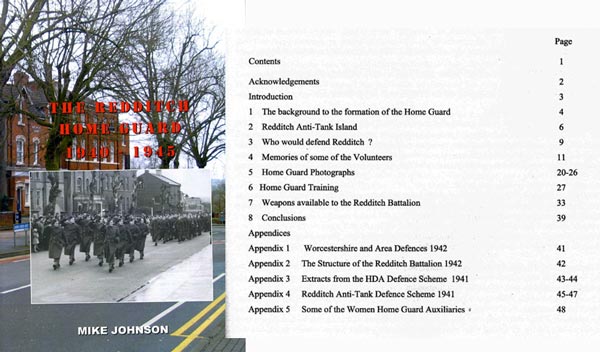
|
Webmaster's note:
The
images on this page come via the courtesy of Messrs. Peter
Grace, Mike Johnson, Bill Preece, Albert Wharrad and Mick
Wilks (the latter providing in particular the images of weaponry)
to all of whom the Webmaster makes grateful acknowledgement.
Mr. Wilks is the co-author of "The Mercian Maquis" - see Links and Further Reading
page.
And
finally....... please do not omit to
contact Mike Johnson via this website
if you can add anything to the Battalion's story.
|